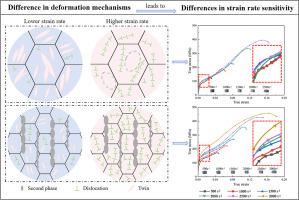元素Ce对Mg-Zn-Zr合金应变速率敏感性的影响
IF 13.8
1区 材料科学
Q1 METALLURGY & METALLURGICAL ENGINEERING
引用次数: 0
摘要
镁合金应变速率敏感性的研究是当前材料科学的一个研究热点。然而,大多数研究……本文章由计算机程序翻译,如有差异,请以英文原文为准。

Effect of element Ce on the strain rate sensitivity of Mg-Zn-Zr alloy
Investigations into the strain rate sensitivity of magnesium (Mg) alloys represent a current research focus in materials science. However, most studies have examined strain rate sensitivity in single alloy, lacking systematic comparisons between different alloys. In the present study, a series of ZK60-xCe (x = 0, 0.3, 0.8, 1.3) alloys were fabricated via hot extrusion deformation. The microstructure evolution and strain rate sensitivity of these alloys under dynamic compressive loading were systematically investigated. According to thermal activation theory calculations, the strain rate sensitivities of ZK60-xCe alloys are predominantly governed by their deformation mechanisms. The enhanced strain rate sensitivity observed in Ce-containing ZK60 alloys is primarily attributed to their high dislocation density. This correlation stems from two key factors: (1) Ce-containing alloys demonstrate significantly higher ΔE and ΔT values compared to the base ZK60 alloy, providing the necessary energy conditions for high-density dislocation generation; and (2) the Ce addition effectively promotes 〈c + a〉 slip activation and facilitates cross-slip behavior. It is hoped that this work can provide a new perspective for the study of strain rate sensitivity in Mg alloys and offer a methodology for comparing strain rate sensitivity among different alloys.
求助全文
通过发布文献求助,成功后即可免费获取论文全文。
去求助
来源期刊

Journal of Magnesium and Alloys
Engineering-Mechanics of Materials
CiteScore
20.20
自引率
14.80%
发文量
52
审稿时长
59 days
期刊介绍:
The Journal of Magnesium and Alloys serves as a global platform for both theoretical and experimental studies in magnesium science and engineering. It welcomes submissions investigating various scientific and engineering factors impacting the metallurgy, processing, microstructure, properties, and applications of magnesium and alloys. The journal covers all aspects of magnesium and alloy research, including raw materials, alloy casting, extrusion and deformation, corrosion and surface treatment, joining and machining, simulation and modeling, microstructure evolution and mechanical properties, new alloy development, magnesium-based composites, bio-materials and energy materials, applications, and recycling.
 求助内容:
求助内容: 应助结果提醒方式:
应助结果提醒方式:


